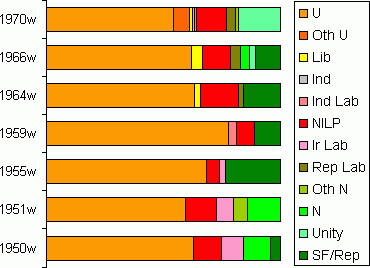

 |

|
| |
| |
By 1970 Northern Ireland was in a state of crisis and a major political realignment was underway. The reform minded O’Neill had resigned in May the previous year and was succeeded by his cousin Major James Chichester-Clark; the fifth Prime Minister of Northern Ireland. Protestant discontent at O’Neill’s moderation towards the Catholic minority had continued to grow throughout his term in office. This resentment was effectively channeled by Ian Paisley with his “O’Neill Must Go” campaign, and he and his supporters hounded O’Neill at all public functions.
Despite the initial Catholic support that O’Neill had won through a number of ground-breaking gestures, this soon turned to disappointment at the lack of meaningful reform. Catholic frustration found an outlet in the Northern Ireland Civil Rights Association. This umbrella organization was formally inaugurated in 1967 and its aims were to demand a number of liberal reforms, including the removal of discrimination in the allocation of housing and jobs, the removal of permanent emergency legislation and an end to local government electoral abuses.
Modeled on the American civil rights movement, NICRA’s tactics included street protests, marches, sit-ins and the effective use of the media to publicise grievances. These protests frequently led to loyalist counter demonstrations and ultimately to conflict with the forces of the state. As more militant elements came to the fore, the Stormont government was unable to handle the growing civil disorder, and in 1969 the British government sent in troops to restore order. Although initially welcomed by the Catholic population, the intervention soon proved to be a trigger for the revival of the republican movement and the establishment of the Provisional IRA.
When the votes were counted it revealed the Unionists' worst ever result in a Westminster election, capturing only 54% of the vote and winning eight of the twelve available seats. Unity candidates were successful in Mid-Ulster and Fermanagh & South Tyrone, and Gerry Fitt successfully defended his West Belfast seat with an increased majority. These seats with their large Catholic populations were considered to be marginal, however the victory of Protestant Unionist candidate, Ian Paisley, in North Antrim was a major blow to the establishment.

This map by Conal Kelly shows
the winner in each constituency in 1970.
| Party | Votes | % Share | Seats Won | |
| Unionist | 422,041 | 54.2% | 8 MPs | (Armagh , East Belfast, Londonderry, North Belfast, North Down, South Antrim, South Belfast and South Down) |
| Unity | 140,930 | 18.1% | 2 MPs | (Fermanagh & South Tyrone and Mid Ulster) |
| NILP | 98,194 | 12.6% | ||
| Protestant Unionist | 35,303 | 4.5% | 1 MP | (North Antrim) |
| Republican Labour | 30,649 | 3.9% | 1 MP | (West Belfast) |
| Independent Unionist | 17,787 | 2.3% | ||
| Liberal | 10,929 | 1.4% | ||
| NDP | 10,349 | 1.3% | ||
| Independent Labour | 7,565 | 1.0% | ||
| Independent | 4,290 | 0.6% |

Other sites based at ARK: ORB (Online Research Bank) | CAIN (Conflict Archive on the INternet) | Northern Ireland Life and Times Survey
Your comments, please! Send
an email to me at nicholas.whyte@gmail.com.
Conal Kelly, 1 June 2007.
|
Disclaimer:©
Nicholas Whyte 2005 Last Updated on Saturday, May 07, 2005 09:42:49
|